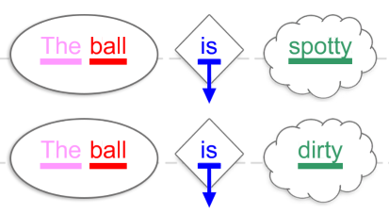MC4 subject + adjective
You will need:
- Toys/images
- Oval, diamond and cloud shapes and/or SHAPE CODING app
App setting: Default
Intervention steps:
- Introduce the target sentence pattern: oval (who), diamond (don’t focus on this though at this stage), cloud (what like/how feel). Discuss how the cloud shape tells us WHAT the oval shape is LIKE. Check the child understands this.
- Point at the shapes whilst saying the sentence.
- Write the words in the slots in the correct colours (or use the app). If using physical shapes, for the oval, you could just put a toy item you are describing on the shape rather than writing the word.
- Say the sentence (or get the app to play the sentence) whilst pointing at each word.

- Turn the oval over (or long press on the app) to show the WHO/WHAT and ask “What is dirty?” or “What is spotty?” Turn it back to show the answer (the ball).
- Turn the cloud over to reveal WHAT LIKE and ask “What is the ball like?” (it is not yet possible to split the what and like on the app, so you will need to just ask orally, splitting the cloud is too complex at this stage anyway, see Q18). Turn the cloud back to the answer (spotty/dirty).
- Create new sentences using the shape template (either copy the template on the app and fill in new words, or write/draw on physical shapes using pens, or just orally point at the coloured lines on the shapes). If the child is not yet able to produce determiners (pink words), either ignore this and allow “ball (is) spotty”, or use names instead. If the child omits the copula is (see TA2), this may be an additional target. If not appropriate at the moment, use full sentences, but don’t worry if the child doesn’t – that can be a later target.
- When several sentences have been created, ask questions and get the child to answer them, for example:
-
- WHAT is spotty?
- WHAT is dirty?
- WHAT is green?
- WHAT is the car LIKE?
- WHAT is the ball LIKE?
- Now introduce HOW FEEL for emotions of characters. Put a picture of a person showing an emotion on the oval. Ask the child e.g. “how does the boy feel?”. Help the child to provide the answer, e.g. sad, happy, cross, hungry. Ask questions about the oval e.g. who is sad? and get the child to provide the answer. Then create sentences to fit the pattern, e.g: the boy is sad / happy / hungry / cross / sleepy.
- If consolidation is required, describe properties of objects in the environment or emotions of characters in films. For a child who can read, you might also like to use this PowerPoint.
© Moor House School & College

